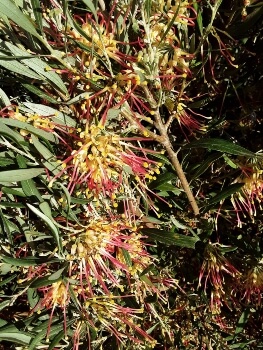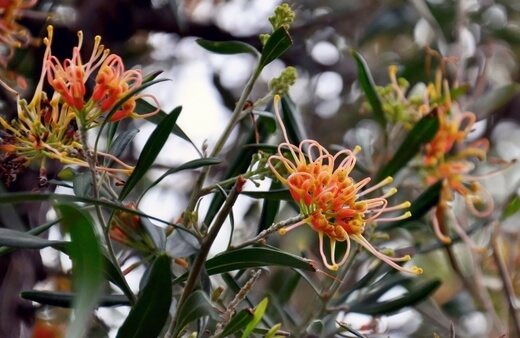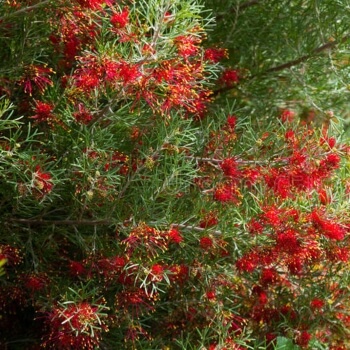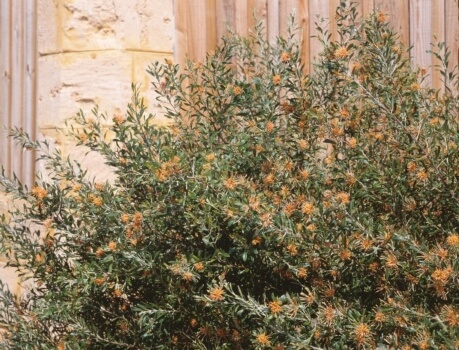A blooming shrub like the Grevillea olivacea is one of the most beautiful things you can have in your garden. It adds structure and you can create privacy or just little pockets to hide away in. A display of bright flowers that attract wildlife then make this garden feature a real prize.
In our how to grow and care guide, we’ll go through the Grevillea olivacea in more detail and why this plant would be the perfect addition to your garden.
More...

Family: | Proteaceae |
|---|---|
Genus: | Grevillea |
Species: | G. olivacea |
Common Name: | Olive Grevillea |
Location: | Outdoor |
Type: | Shrub |
Growth: | Up to 4 metres tall and 6 metres wide |
Sun requirements: | Prefers full sun |
Foliage Colour: | Olive Green |
Flower Colour: | Yellow, red, orange |
Flowering: | Spring, winter |
Fruit: | None |
Maintenance level: | Low |
Poisonous for pets: | No |
Introducing Grevillea olivacea

The Grevillea olivacea found its roots on the coasts of Western Australia. It’s a tough type of Grevillea and offers up some gorgeous flowers, starting in the winter and through to spring. Shades of red, orange and yellow will brighten up your garden.
The name of the shrub makes reference to the leaf colour which is similar to the shade of green that you would find on an olive tree. Grevillea olivacea can grow to a height of 4 metres and is able to spread out up to 6 metres. The plant can live for around 10 years or more.
Olive Grevillea’s flowers are much loved by birds that come and enjoy their sweetness. The flowers have a long blooming time and you might want to snip some of them from the garden to put in a lovely vase.
If your garden is in need of a hedge or screen, Grevillea olivacea will provide the needed structure and beauty once it’s at least a metre in height. The shrub, if left to grow unaided, becomes round and bushy.
Grevillea Olivacea Varieties
Grevillea olivacea two tone

Source: Trigg Plants
This variety is usually around 3 metres tall and spreads out about 2 metres. It has both red and yellow flowers in abundance. The leaves are dark green and it’s naturally upright.
Grevillea olivacea ‘Apricot Glow’

This cultivar has thick and dark green leaves. The flowers are an apricot colour as the name suggests. It usually grows to about 3 metres in height and to a maximum of 2 metres wide.
Grevillea olivacea yellow

Source: Lakeside Nursery
This variety has yellow flowers and blooms for an extended period of time. It grows up to 4 metres high and 4 metres wide. The leaves are a deep green colour.
Grevillea olivacea Varieties
Grevillea olivacea two toneThis variety is usually around 3 metres tall and spreads out about 2 metres. It has both red and yellow flowers in abundance. The leaves are dark green and it’s naturally upright. |  Source: Trigg Plants |
Grevillea olivacea ‘Apricot Glow’This cultivar has thick and dark green leaves. The flowers are an apricot colour as the name suggests. It usually grows to about 3 metres in height and to a maximum of 2 metres wide. |  |
Grevillea olivacea yellowThis variety has yellow flowers and blooms for an extended period of time. It grows up to 4 metres high and 4 metres wide. The leaves are a deep green colour. |  Source: Lakeside Nursery |
How to Grow Grevillea olivacea
The plant thrives particularly along the coast. When thinking about lighting needs, full sun is ideal but some shade will also be fine. The Grevillea olivacea needs good drainage when it comes to soil and slightly alkaline is fine.
It’s able to adapt to many different types of soil. The shrub can also handle some drought and frost. True to its ability to be a good screening plant, the Grevillea olivacea can handle pruning and helps to add structure to the plant.

Propagating Grevillea olivacea
How to Propagate Olive Grevillea from Seeds
This is the more lengthy route to go but if you have time and aren’t in a rush, you can allow the seed of the Grevillea olivacea to germinate on its own without needing to treat it beforehand. If you just leave the seed in soil, it will germinate within a year or two.


Get Your Free Guide:
Master Growing Australian Natives eBook
A Must Have Complete Guide for Every Australian Garden
Get Your Free Guide:
Master Growing Australian Natives eBook
A Must Have Complete Guide for Every Australian Garden
As the seasons progress and the soil becomes wet and dry in rotation, the seed coat cracks open and this then starts the germination process.
Propagating Olive Grevillea from Cuttings
The best time to take a cutting is during the summer or at the start of autumn. The cutting should be semi ripe and aim for a length of around 10 centimetres. You can dip the Grevillea olivacea cutting into a rooting hormone and then plant it in a container with coarse sand.
Give it a little bit of water and be careful not to overwater. Your cuttings shouldn’t be directly in sunlight and the best way to maintain moisture levels is to mist them often. It can take around 6 months for new roots to sprout.
How to Care for Grevillea olivacea

Source: Pot Plant Heaven Perth
Climate and temperature
The G. olivacea can handle both warm and cool temperate conditions and also a Mediterranean climate. It does particularly well in coastal areas and the ideal time to plant it would be during autumn or winter.
Soil
G. olivacea likes a neutral or alkaline soil. It can adapt to many soil types including, sandy, loamy, and clay loam. Whichever soil you are growing it in, there should be good drainage.
Watering
This shrub doesn’t need much water once it’s established, even in the summer. If you overwater G. olivacea, you could end up with root rot.
Pruning
G. olivacea likes pruning and this is the perfect way to keep it in shape. Depending on the needs of your garden, you can opt for a size and shape that works for you.
What Fertiliser to Use
When you initially plant your G. olivacea, you can give it a slow release native fertiliser and then do an annual top up each year in spring.
Pests and Diseases to Look Out For
Scale
Scale is a type of sap sucking insect that likes to hang out on the stems, branches and leaves of plants. If you want to use an organic and environmentally friendly method to get rid of this pest, neem oil is a great way to go.
Refer to our in-depth guide for neem oil to learn its types and how to use them the right way.
If you are dealing with a very big infestation, you might need to use an insecticidal soap instead. Whichever treatment you are using, you can spray the entire plant and then wipe the leaves and parts of the plant affected with a paper towel.
Grevillea olivacea Frequently Asked Questions

Source: Lullfitz Nursery
What is the conservation status of the Grevillea olivacea?
G. olivacea is listed as "Priority Four" by the Government of Western Australia Department of Biodiversity, Conservation and Attractions. This rating means that it is rare or near threatened.
Does the Grevillea olivacea cause allergies?
Grevilleas in general can cause skin irritation. If you find that you are sensitive, just cover up your skin when you’re busy with them in the garden.
Can Grevillea olivacea handle wind?
G. olivacea has earned itself a reputation for being hardy and can indeed handle wind except in a very hot and desert-like climate.
Do the roots of the Grevillea olivacea grow quite deep?
G. olivacea has a shallow root system. This means you don’t have to worry about any structural damage around your home or garden.
Does Grevillea olivacea attract bees?
The delightful flowers of the G. olivacea make plenty of nectar and this attracts many native bees.
Why does my Grevillea olivacea have yellow leaves?
If you notice the leaves of your G. olivacea turning yellow, it could be that the iron, phosphorus and pH levels of the soil are unbalanced. This is especially true if there is too much phosphorus in the soil.
If you’re looking for more garden inspiration and advice, sign up for our newsletter.
Can't get enough of Grevilleas? Check out our main Grevillea growing guide.
Wrapping Up Our Grevillea olivacea Guide
The Grevillea olivacea and I have two things in common – we thrive the most when living close to the ocean, and our original home is Western Australia. Perhaps this is why I feel a special connection to this type of shrub and would recommend it for any garden. I’m giving the Grevillea olivacea my green thumbs up!
Published on February 15, 2023 by Nathan Schwartz
Last Updated on January 26, 2025




